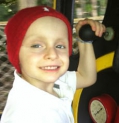Exploiting a Novel DNA Repair Defect in Ewing Sarcoma

Ewing sarcoma is a group of bone and soft tissue cancers that can occur in children, adolescents, and young adults. The high response rates to DNA-damaging chemotherapy suggest that there may be defects in DNA damage repair pathways that make Ewing sarcoma cells susceptible to chemotherapy-induced DNA damage. However, despite these high response rates, there is still an urgent need for new treatment options for Ewing sarcoma, particularly for patients with relapsed and/or refractory disease. The chromosomal translocation that occurs in Ewing sarcoma cells leads to the generation of the EWS-FLI1 oncoprotein in combination with the loss of an allele of intact EWSR1. However, the mechanism by which EWS-FLI1 expression or loss of EWSR1 affects DNA damage repair pathways is still largely unknown. We discovered that expression of EWS-FLI1 or loss of EWSR1 leads to a unique damage repair defect. Due to this unique defect, Ewing sarcoma cells are hypersensitive to radiation and specific chemotherapy. By exploiting this defect, we have identified a potentially synergistic therapeutic strategy for Ewing sarcoma cells. Therefore, we hypothesize that exploiting this intrinsic DNA damage repair defect of Ewing sarcoma cells will allow us to develop therapeutic advantages by targeting other DNA repair pathways concurrently with the standard treatment used in the clinic.
Project Goal:
The goal of this project is to discover new treatment options with novel mechanisms of action for recurrent and/or refractory Ewing sarcoma. To achieve this goal, we will first elucidate the precise mechanisms by which EWS-FLI1 expression or loss of EWSR1 causes this unique DNA damage repair defect using biological and biochemical approaches. Second, we will evaluate the consequences of this unique DNA damage repair defect in Ewing sarcoma patients by analyzing genomic data. Third, we will identify a novel molecule that shows a synergistic effect with this DNA damage repair defect in Ewing sarcoma cells by screening. Finally, we will confirm the efficacy of our new combination strategy in vivo using a mouse model. If our preclinical studies show promising results, there is great potential for translation to the clinic in an investigator-initiated clinical trial.

